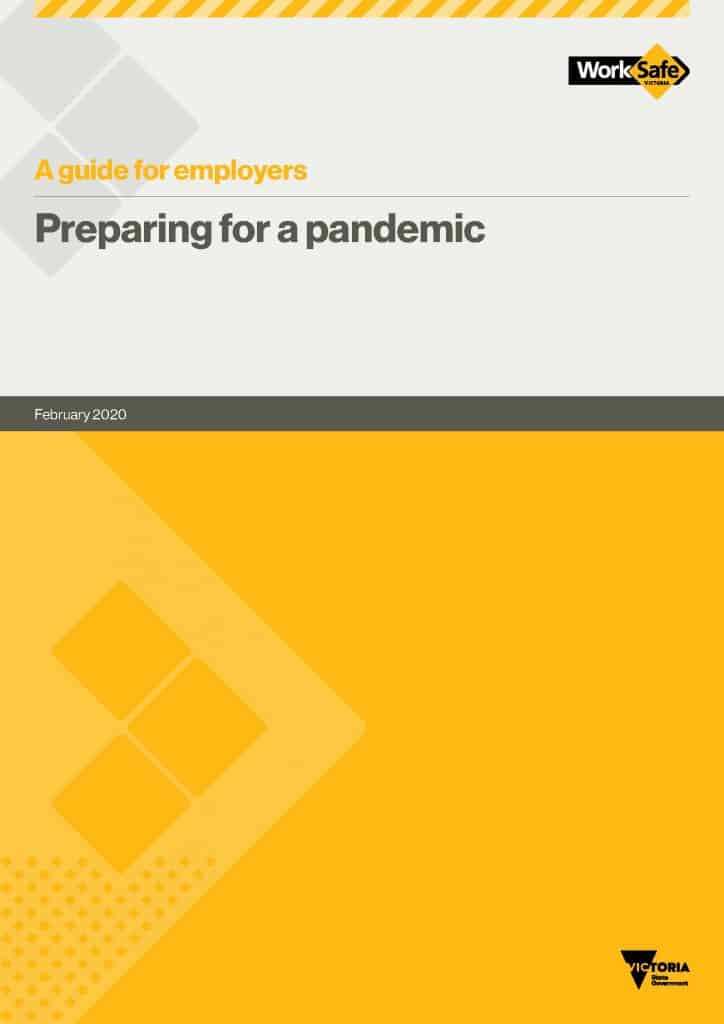
Every occupational health and safety (OHS) man and their dog is providing advice about how to manage the COVID19 pandemic. The only advice this blog has offered is to target your sources of information about managing the risks to your local health department or OHS regulator. This information is changing all the time in response to new information but there are a couple of OHS guidances that are worth paying close attention to.
The most useful one is that produced by WorkSafe Victoria – “Preparing for a pandemic: a guide for employers”. A major attraction with this guide is that it was published in February 2020 prior to the major disruption to Australian businesses. As such the information is generic and, in some ways, more useful. The information stays within the OHS duties set through legislation, offering a pandemic context. This builds on the safe systems of work that should already be in place and should make the suggested changes more palatable. The guide uses “good OHS practice” as its base, and expands on each of these points:
“Good OHS practice in planning for a pandemic requires the employer to:
1. keep informed and up-to-date on pandemic information
2. educate and keep employees up to date
3. undertake OHS risk management by managing the direct and indirect risks
4. incorporate OHS preparations and risk control measures into a business continuity plan
5. review and evaluate risk control measures
6. plan and manage the recovery phase of a pandemic”
page 6
The SafeWorkNSW guidance is more specific to COVID19 and aligns more with Health Department recommendations. This makes the information more topical but also locks the website into more frequent updates than Victoria would need. Victoria recommended companies establish a framework headed by “a pandemic disease manager” so that there is a single point of information and decisions. NSW does not talk about this role, but it is an essential one in any pandemic plan.
The SafeWorkNSW guidelines, by trying to do so much, makes the process seem complex. Partly this is because this pandemic appeared so quickly but also because Australia has always be a little complacent on these risks due to our comparative isolation. SafeWork urges employers to develop a pandemic plan whilst also acknowledging that the best time to do so has probably past and that all employers can do now is make do with what expertise and resources are available.
WorkSafe Queensland has several pages related to OHS and COVID19 but the most useful is about risk management. It, of course, echoes the advice from the local Health Department but keeps the advice simple and logical. The OHS context is obvious but readers could have been reassured more by explaining that these recommendations build on the safe systems of work that employers have already established – helping to reassure that the changes are a step-up on what is already in place rather than having to run around creating something new.
The specific advice for workers and employers on “Preventing the spread of infection at work” is good and simple.
One noticeable tone in much of the OHS advice is a little too much caution on the issue of when to send a potential ill worker home. The OHS advice often is to “encourage” a worker to stay home if they are feeling unwell. In times of a pandemic, discretion is not always the best option. The Fair Work Ombudsman’s advice on “Coronavirus and Australian workplace laws” is more decisive and asks
“When can employers direct employees to stay away from their usual workplace under workplace health and safety laws?”
The OHS duties of employers for a safe and healthy work environment demands that workers be sent home if hazardous, and the employee duties are that they must not come to work if they are hazardous. Consultation is essential in OHS management but sometimes an employer must be decisive.
The job of managing OHS in this time of pandemic will be much easier by focusing on authoritative, useful and simple advice, especially when everyone from suppliers, unions and wellbeing experts are sending through emails about how to cope. Coping is important but this should be done with the minimum of anxiety.
So, SafetyAtWorkBlog’s advice is to continue to focus on your work, on making things and providing important services. COVID19 is a significant disruption and one that is made worse by confused information. Yes, our state of knowledge of the risks and hazards may change on a daily basis, but that is only one element on which good, reasonably practicable, OHS decisions are made.
